Whether you’re
freighting gear into the backcountry, camp-cruising a shoreline
with the grandkids or just poling through the Ozark swamps on the
lookout for that flashy ivory-bill woodpecker, this 12 foot motor
canoe might be just the ticket.
The simple double chine plywood construction produces
a lightweight hull that can be car-topped and versions built with
selected lightweight materials weigh between 50 and 60 pounds. It
can be loaded and unloaded by one person, and to make launch and
retrieval easier, with the slick graphite bottom it can be dragged
over parking lots, launch ramps and portages.
The wide bottom provides maximum stability for a
boat this size and the 45 inch overall beam provides extra space
for cargo. The seating arrangement presents various options for
tie-down of gear and passenger loading. With a motor control extension
handle a single operator can sit near the center of the hull for
optimum trim, or on the aft compartment and the hull can be balanced
with passengers or gear placed forward. Oarlocks can be attached
at any point along the gunnel to allow rowing from any seat location,
and oars can be stowed inside the boat under the seats. Colored
areas on the deck are non-skid surfaces to provide secure footing
when standing or stepping aboard.
The 2 large fore and aft watertight compartments
provide secure dry storage, hull reinforcement and emergency flotation
should the hull accidently fill with water. The compartments also
provide seating and are accessed by simple screw-out plastic ports
or a hinged hatch.
The hull and seats are built from plywood sealed
with epoxy to provide a tough slick surface which does not water-soak
and is easy to maintain over the long term. For a final finish the
hull can easily be painted out or varnished natural. Epoxy is used
to join ply panels with doubler-pads and no exacting woodwork is
required. Hull seams are covered and reinforced with a strip of
fiberglass tape on the exterior and a bead or fillet of thickened
epoxy on the interior. No metal fastenings are used in the hull.
The plywood and epoxy construction technique is well suited to novices
and is simpler than traditional wood building methods.
The freight canoe is not designed as a fast boat,
but the smallest of transom-mounted motors will push the lightweight
hull. The transom is reinforced with compression pads, the aft compartment
deck, large interior epoxy fillets and fiberglass tape on the exterior.
Electric trolling motors are quiet and almost vibration free and
small gas motors also work well. Batteries or a gas tank may be
isolated in the aft compartment or secured under the seats.
The 34 page building plans are written for first-timers
and are very detailed with photos and sketches in a step-by-step
format. The plans also discuss many options to modify and customize
the basic boat. Lightweight and heavy duty building techniques are
discussed, along with mail order material sources. Interior compartment
layout, seating, hull reinforcement, trim and final finish are all
optional depending on how the builder plans to use the boat.
Paul, I would
like to let you know why this boat excites me so. I live on
the Eastern Shore of Maryland and I hunt Sika deer which is
a miniature form of Elk. They are wild on the Assateague Island
Seashore Federal Reserve and the state opens hunting to them
in the fall. For a number of years I have heard them bugle
on islands that are inaccessible to the walk-on hunter as
they are surrounded by Tidal waters and since I usually hunt
alone, dragging a boat thru the marsh is all but unthinkable.
I am 52 as well so age does factor in. Also, I love to clam
and again this design is perfect to reach these tasty little
buggers around our tidal waters. So, hopefully I will be enjoying
them this summer as well. Thanks again and I will send you
my photos.
Duane
|
Hello again paul….and
thanks for the speedy replies. I really like this plywood
and epoxy style of building because I can modify the boat
as I build and I just keep getting new ideas. Thanks for encouraging
and helping me sort through all my ideas for the Max boat
my daughter and I built this last year. Now I think the freight
canoe will be another fun project but just wait till you hear
some of the modifications I have in mind. I also like your
electric motor ideas, and I will make the underseat compartment
we discussed a space for a primary and a spare battery.
I know you told me the Max boat is
simpler to build than the double chine canoe, but my daughter
and I had a lot of fun and the boat is perfect for fishing
here in Idaho and now I can hardly wait to get started on
the little freight canoe, so I’m sure I’ll be
in touch with more ideas and questions.
Okie. Boise, Idaho |
…..perfect for birdwatching with
my wife in the small lakes and streams here in western Montana.
I’ll build the lightweight version. Nels. H. Libby,
Montana |
Paul.....I ordered a set of plans from you the first part of the year. Finally got a chance to build it, and try it out. This is the first boat I have built and I really enjoyed it. Anyways, thought I would send you a picture, and say thanks for the great set of plans.
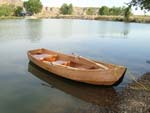
click image to enlarge
Josh. Glendive, MT |
Hi Paul, Sorry I don't have those pictures. The camera worked just about as well as our fishing luck. We took the boat over to the Pot Holes Reservoir and the seep lakes in May and June and have had it on several Pierce County lakes, even though we haven't done too well fishing it's been just the ticket for a good time. Easy to launch and load and it rowed like a dream with 2 guys, tackle, life jackets and lunch, etc. With the addition of a small electric motor it still is shallow draft and went a lot faster than we had anticipated. Surprisingly, even without a keel it wasn't overly affected by the eastern Washington winds when rowed or with the motor.
I can't tell you how many guys stopped to look the boat over and admire the lines and overall workmanship. I gave several your web site address. Other than poor fishing we had only one other problem... and that was very minor leakage through several of the zip tie holes on the first day at the Pot Holes. It was only minor... I would guess 3 or 4 ounces of water over a period of nearly 8 hours and with another use for Duct Tape that problem was solved in the field. On a more permanent basis with additional coatings of epoxy and graphite I think the problem has been solved. All in all I would say, and I think my brother would agree, the canoe out performed his aluminum skiff of similar size. Thanks again for the great boat.
Allen |
|
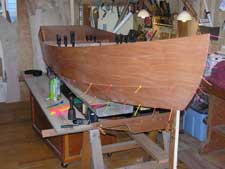
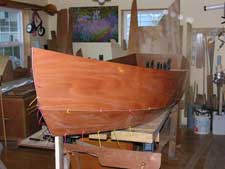
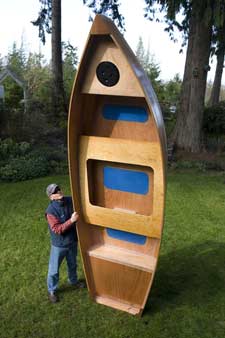
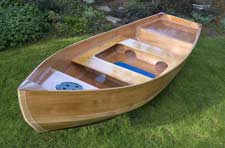
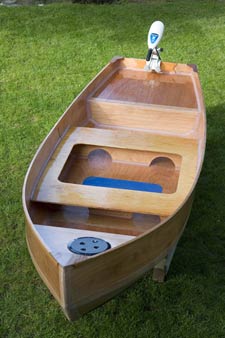
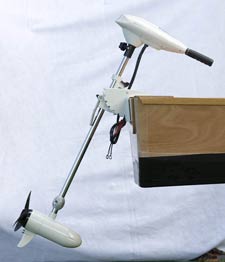
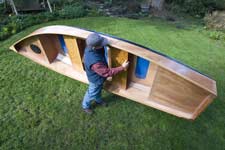
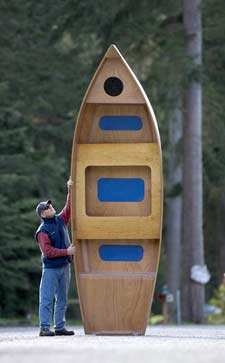
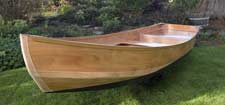
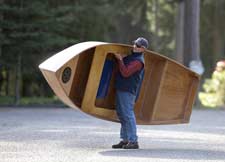
|